Abstract
Renewable alternatives to fossil fuels, such as biodiesel, are necessary to lessen emission of greenhouse gases that are causing climate change. Using a high-pressure, medium-duty, common-rail, turbocharged four-cylinder diesel engine, this work studies the effect of adding Cocos nucifera biodiesel to conventional diesel on exhaust emissions, engine performance, and combustion characteristics. An analysis and characterization of the key physicochemical properties of diesel, biodiesel, and biodiesel–diesel blends were carried out. The engine was fuelled with pure petroleum diesel and blended diesel containing a 10%, 20%, 30%, and 50% volume of coconut oil at full throttle and six different speed settings, respectively. The results showed relatively close physicochemical properties between the biodiesel blend and conventional petroleum fuel. Observations made over the entire speed range indicated that a higher coconut oil biodiesel (COB) content lowers the torque and brake power compared to diesel. In the case of engine exhaust gas, a reduction in carbon monoxide (CO) and smoke emissions were observed. Notably, COB50 gives out the highest nitrogen oxides (NOx) but it is raised even for other blends. The experimental results also demonstrated that a higher COB content achieves a lower peak pressure while the peak heat release rate (PHRR) was lower than that of conventional diesel as the speed of the engine increases.
1. Introduction
Petroleum-based fuel has become the worldwide main source of energy and this fuel usage had taken up a percentage of 85% (32% crude petroleum oil, 29% coal, and 24% natural gas in the year 2015). The fuel demands continue to steadily increase and it is predicted that the petroleum supply will barely able to uphold about 50% of the regular demand by 2030 [1]. The forecasted global fuels demand by 2040 is presented by [2]. In the long run, the global energy demand is speculated to grow by an average of 1% per annum from 2010 to 2040. The ever-increasing demand for fuel also serves to intensify environmental pollution and greenhouse gas emissions, which are closely linked to overwhelming climate change [3]. It has become a worldwide matter to develop clean fuel that is environmentally acceptable, domestically available, and, at the same time, technically feasible [4]. Generally, the treated form of vegetable oil or animal fats (biodiesel) receive much attention for it offers an attractive alternative fuel for compression engines.
Biodiesel can be derived from a variety of oils and fats that had undergone a transesterification process with alcohol; thus, it consists of long-chain fatty acid esters, generally methyl esters, of the parent oil or fat [5]. This reaction allows biodiesel to gain a viscosity similar to that of petroleum fuel. It is worth pointing out that biodiesel is different from renewable diesel that is produced by the hydrotreatment of bio-derived oils or fats in a refinery, leading it to have non-oxygenated and paraffinic properties [6]. Biodiesel is comparable to standard diesel in terms of its main characteristics. Even though with the absence of a petroleum content, it is compatible with diesel fuel and, thus, can be blended into any ratio to produce a stable biodiesel blend [7]. An engine that uses vegetable oil–diesel blends tends to last longer compared to an engine that uses straight vegetable oil [8]. Biofuels consists of many desirable attributes. Nonetheless, some of its characteristics require improvements to boost its widespread acceptance.
From its domestic origin, biodiesel is a renewable, oxygenated, and ecological biofuel with inconspicuous emissions [9]. Because of its non-toxicity, lower sulphur level, and higher cetane number [10,11,12], biodiesel has the capability to notably reduce most regulated exhaust discharges, such as hydrocarbon (HC), carbon monoxide (CO), particulate matter (PM), polycyclic aromatic hydrocarbons (PAH), sulphur dioxide (SO2), and nitric polycyclic aromatic hydrocarbons (nPAH) [12,13,14,15,16,17]. Together with its excellent lubricity and high flash point, biodiesel shows high potential in providing a sure solution to reduce the reliance on petroleum, especially in the transportation sector [18,19]. According to the Biofuels Association of Australia, biodiesel capacity was found to have doubled since 2006 when companies in the European Union generated more than 10 million tons in 2013; whereas, in biodiesel markets in the United States and Asia, it is rapidly growing [20]. The daily application of biofuels is predicted to increase from 1.3 million barrels of oil in 2012 to 4.6 million barrels of oil in 2040. It is also projected that their share of road-transport fuel demand will be brought up to approximately 8% [21].
However, there are some present drawbacks to biodiesel use, which include the increased nitrogen oxide (NOx) emission, as proven by a majority of research results [22,23,24]. This increment is referred to as the “biodiesel NOx effect” [25,26]. There are claims that the rise in NOx emission does not rely on only a single factor, but may be due to a combination of factors that happens to be dependent on each other, particularly the complex physicochemical properties of the fuel [27]. Various attempts have been made to reduce the NOx exhaust discharge, ranging from adding additives, reducing unsaturation, as well as modifying the feedstock composition by blending it with another diesel fuel [21,28,29]. Other disadvantages of biodiesel are their innately high viscosity that leads to poor fuel atomization and incomplete mixing with air during the combustion stage. The lower heating values and lower volatility of biodiesel contribute to unburned fuel that will coke the injector, clog the filter, damage the pump, and deposit excessive carbon in the engines [2,7,18,30,31]. Biodiesel not only produces a slight loss in engine power and torque while it raises the brake-specific fuel consumption (BSFC) relative to petroleum diesel, but also decreases oxidative stability and degrades cold flow performance [22,23,32,33]. A lower oxidation stability may corrode the engine components by damaging the plastic materials used for hoses, seals, coatings, and paints [1,7,27,34,35,36,37,38]. Moreover, it increases the dilution of the lubricating oil when the fuel impinges on in-cylinder surfaces pre- or post-injection, thus increasing the need for frequent oil changes [12].
According to Carraretto et al. [14], regarding a six cylinder, direct injection diesel engine, an increase in biodiesel content in a blend decreases both the power and torque slightly across all speed ranges. This is especially so when pure biodiesel was used, bringing a reduction to maximum power by around 3% and to maximum torque by around 5%. Furthermore, maximum torque was achieved at a higher engine speed with pure biodiesel. The investigation made by Aydin and Bayindir [39] obtained similar results by using cottonseed oil methyl ester (CSOME) but the same study was discovered to have a similar decrease in SO2 and CO emissions. In another study [40] that used waste cooking biodiesel, a similar power and torque output with higher BSFC were recorded when compared to diesel fuel, while in the case of exhaust emissions, it is revealed that emissions of CO and HC had decreased.
Generally, the biodiesel fuel property depends on its source [41]. Biofuels possess a few variations in their physicochemical properties with respect to conventional diesel fuel, such as its cetane number, calorific value, viscosity, cloud and pour points, as well as oxygen content, so variation in engine performance is to be expected when biodiesel is used, seeing as the combustion characteristics such as the peak in-cylinder pressure, heat release rate, combustion duration, ignition delay, and power heavily rely on the fuel’s physicochemical properties [42,43,44,45]. Ng et al. [34] studied the effect of blend fraction and biodiesel fuel using a wide range of saturation levels and composition of fatty acids on the emission of a light-duty diesel engine. The study involved a biodiesel ester of different types, including those derived from palm oil, soybean oil, and coconut oil. The result of the experiment indicated that biodiesel reduces the hydrocarbon (HC) emissions. In terms of NOx emissions, coconut and palm oil biodiesel showed a decrement of 5.4% as compared to the diesel fuel but soybean biodiesel reported an increment of 8.4%. This is because the fatty acid composition of soybean has a higher number of double bonds, as discussed by the researcher. On the other hand, it should be noted that using an engine for fuel testing is the proper solution in laboratory conditions. However, for diesel fuel traders and end-users, sensors [38] that can point to the usability of a biodiesel fuel blend in a few minutes and with a low sample volume may be critical. Moreover, classification of diesel fuel quality with sensors may require advanced signal processing [37]; such tools in the future may be used in fuel stations to provide end-users biodiesel fuels with proper parameters. This is important as a biodiesel blend’s quality is sometimes subject to subjective consumer discussions.
A common-rail injection system produces atomized fuel for the engine by generating a pressure that is higher than 1500 bar. The high pressure also ensures near complete combustion. This type of modern engine is being equipped in many types of road cars, particularly pick-up trucks, which contributes to the 50% gain in Thailand’s market share [46]. There had been numerous research conducted to investigate the compatibility of biodiesel in a rail injection system [10,11,19,25,47,48,49]. However, the race to find the perfect blend is still ongoing. Lucrative application of vegetable oil–diesel blends as alternative fuel call for good familiarity with the blend’s rheological properties as a function of its composition and temperature. The viscosity of fuel significantly affects the atomization process. Meanwhile, fuel properties are required as input data to diagnose and predict engine combustion models.
Diesel engines have found broad use as a result of higher thermodynamic and thus fuel efficiencies. For this reason, the diesel engine is still in serious use in Europe [48] and it is believed that the traditional internal combustion engine will continue to power the majority of vehicle propulsion for decades to come [50,51]. The main purpose of the present study is to contribute to the efforts toward global sustainability. This paper works to provide useful insights on the impact of blends of diesel oil and biodiesel made from Cocos nucifera oil (coconut oil) in a turbocharged, common-rail, direct injection diesel engine. The engine-out characterization, which includes engine performance, emissions, and combustion characteristics tests, are conducted on four different levels of blends. The effects from the usage of these four blends are compared with conventional diesel to give a better perspective of the combustion that occurred and to bridge the existing research gap.
2. Experimental Methods
2.1. Test Fuels
Analysis of the physicochemical properties of both the neat coconut oil biodiesel and petroleum diesel was carried to determine the suitability of the fuels to be run in diesel engines. The test characterizing their density, kinematic viscosity, cold temperature properties, calorific value, and chemical compositions were carried out according to ASTM and EN requirements, which are the common references for fuel specification and quality tests. The results of the properties tests are as shown in Table 1. In this study, lower-level blends up to 50% were evaluated. They represent a good balance in terms of production cost, material compatibility, emission level, and engine performance. In fact, blends of 20% biodiesel or lower can be operated in diesel engines, which essentially needs very little or no modifications because biodiesel has properties similar to petroleum diesel fuels [36]. In this paper, four blends of different volume proportion of coconut oil biodiesel (COB) with petroleum diesel were prepared as test subjects besides the pure petroleum diesel. Currently, the commercial diesel sold in retail stations throughout Malaysia is B10 biodiesel, which is made up of 10% palm methyl ester (PME) and 90% pure diesel [35]. For this reason, pure diesel (B0) is essential for baseline comparison as well as for blending with coconut biodiesel to eliminate the effect of PME contained in the commercial diesel fuels. In view of this, a conventional diesel fuel (B0) was intentionally procured from the local industrial diesel supplier. This conventional diesel fuel is produced from the fractional distillation of crude oil at the oil refineries. In this study, the blend composition of each fuel is indicated by COBXX, where XX refers to the percentage of COB in the blends. Again, all blends underwent fuel properties tests similar to what were conducted for their source. Some of the diesel blend key properties are presented in Table 2. As expected, the COB–diesel blends exhibit properties that were in-between that of pure diesel and neat COB. The experimental results indicate that the blends exhibit greater densities and higher kinematics viscosities but lower calorific values than diesel. A higher COB content in the blends shows a higher difference in the value of the property between the blends and diesel.

Table 1.
Key physicochemical properties of the petroleum diesel and coconut oil biodiesel (COB).

Table 2.
Fuel properties of the diesel and biodiesel blends.
2.2. Test Engine and Operating Conditions
The apparatus used for this study was arranged and set up as depicted in Figure 1. A turbocharged, direct injection diesel engine operating with a common-rail injection system was used as the test engine. The engine specifications are as shown in Table 3. The engine ran at a maximum torque of 160 Nm and a maximum power of 45 kW while its common-rail injection system operated at a maximum injection pressure of 140 MPa. The tests for each fuel were conducted under ambient temperature in the unmodified test engine that always ran at a full load with variable speed ranging from 1500 rpm to 4000 rpm at 500 rpm increments. An eddy current dynamometer was utilised for measuring the torque and brake power of the engine that was running at full load. Meanwhile, a flow meter was employed alongside with an air mass sensor to determine the fuel consumption. Concurrently, a gas analyser was used to determine the emission level of the various gas exhausts that was directed from the engine to the gas analysers (AVL DiGas 4000 for the measurement of gaseous emissions while DiSmoke 4000 for the measurement of smoke emission). At the same time, a piezoelectric pressure sensor was attached to the engine combustion chamber through a tailored glow plug adapter to monitor the instantaneous in-cylinder pressure and the heat release rate (HRR) of the engine. A shaft incremental encoder with a 0.125 °CA resolution was utilised to keep track of the angular position of the shaft. The signals from the combustion pressure and crank angle were finally inputted into a data acquisition system to be synchronized and recorded.
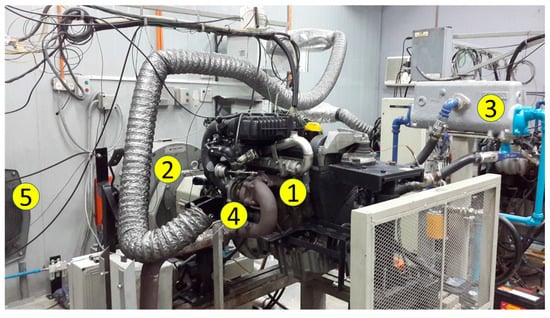
Figure 1.
Schematic of the experimental apparatus: (1) test engine; (2) Eddy current dynamometer; (3) engine coolant heat exchanger; (4) turbocharger; (5) ventilation fan.

Table 3.
Test engine parameters.
Next, following the First Law of Thermodynamics, the HRR achieved by the combustion of each fuel samples was calculated by implementing the following formula into MATLAB:
where accounts for the HRR over 1 °CA, for the crank angle, (=1.37) for the specific heat ratio, for the cylinder pressure, and for the cylinder volume.
3. Results and Discussion
The relationship between independent and dependent variables was graphically represented by 3D response surface plots generated based on the regression model using the experimental data (Figure 2, Figure 3, Figure 4, Figure 5, Figure 6, Figure 7, Figure 8, Figure 9 and Figure 10). These surface plots help researchers to understand the nature of the relationship between the two factors (engine speed and COB blend ratio) and the responses. Different orders of polynomial regression models were considered to establish the mathematical relationship between the response and factors. In the present study, the fully quartic model (i.e., fourth-degree polynomial) was selected to build most of the 3D response surface plots, except for the responses of NOx and peak cylinder combustion pressure, for which we selected the cubic model (i.e., third-degree polynomial).
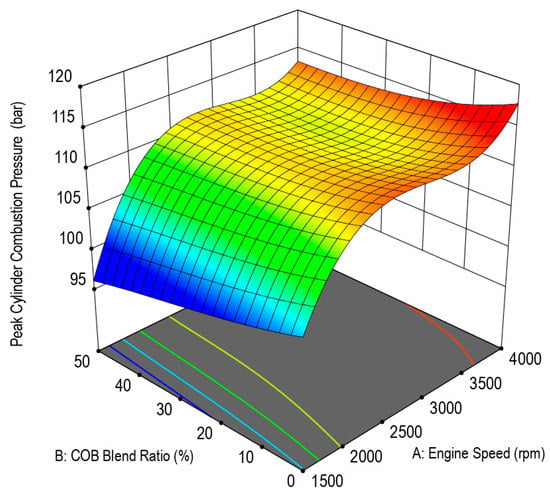
Figure 2.
Peak cylinder pressure for various types of biodiesel–diesel blend fuels at different engine speeds.
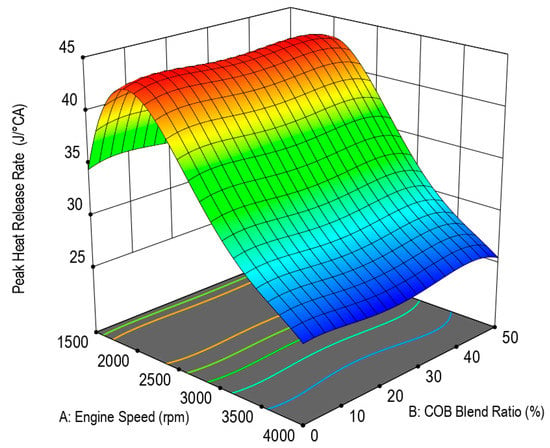
Figure 3.
Peak heat release rate (PHRR) for various fuel blends at different engine speeds.
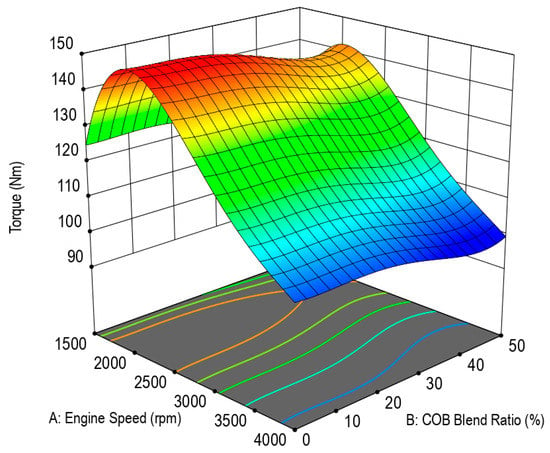
Figure 4.
Engine torque at various engine speeds for all test fuels.
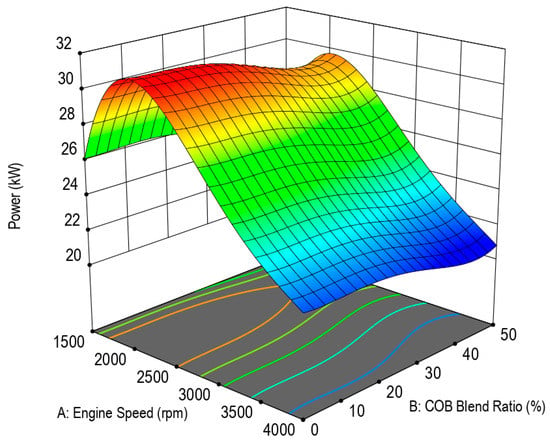
Figure 5.
Brake power at various engine speeds for all test fuels.
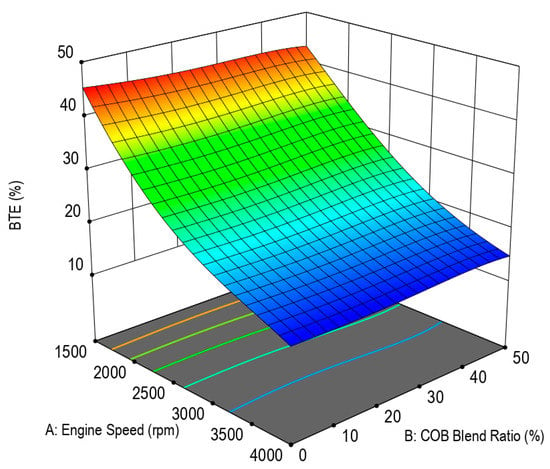
Figure 6.
Brake thermal efficiency (BTE) at various engine speeds for all test fuels.
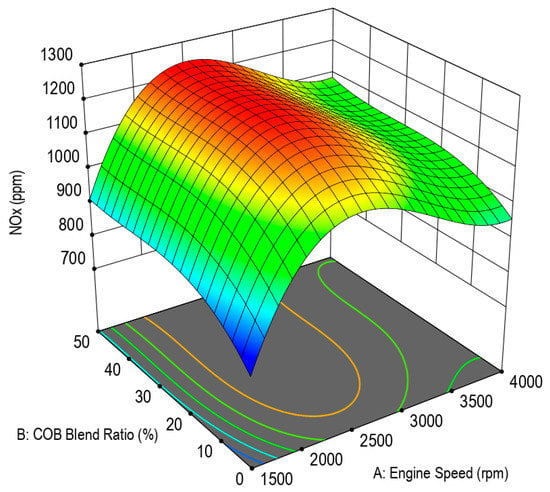
Figure 7.
NOx emissions versus engine speed for all test fuels.
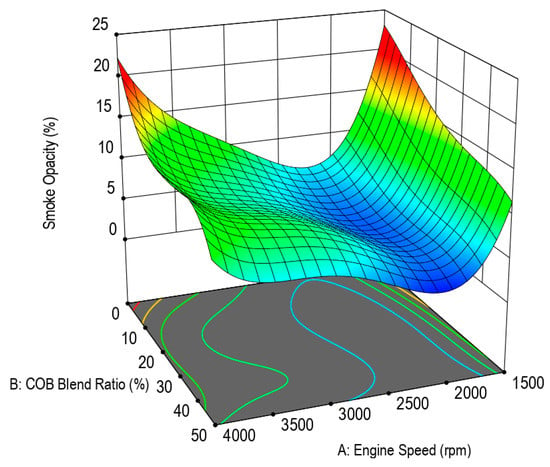
Figure 8.
Smoke opacity at various engine speeds for all test fuels.
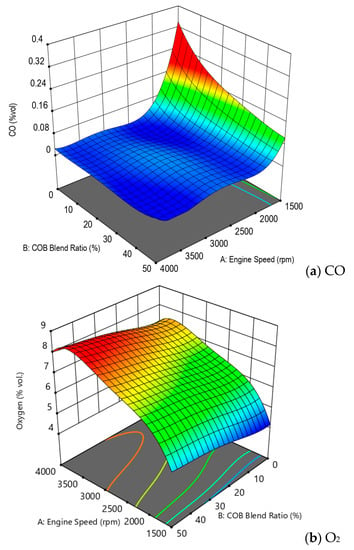
Figure 9.
(a) CO and (b) exhaust oxygen concentration versus engine speed for all test fuels.
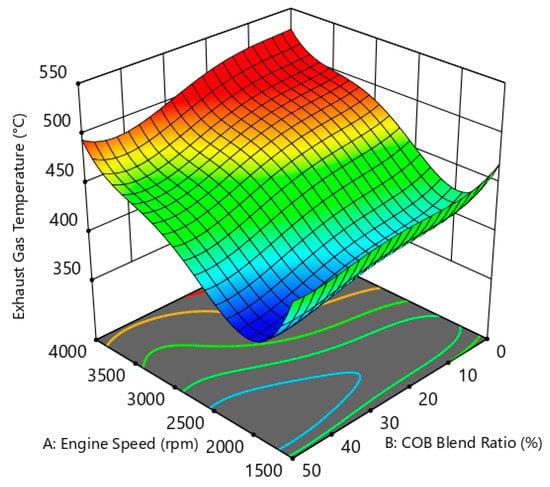
Figure 10.
Exhaust gas temperature (EGT) versus engine speed for all test fuels.
3.1. Combustion Characteristics
3.1.1. Cylinder Pressure at Various Engine Speeds
According to previous researches, cylinder pressure was found to be affected by several factors, including fuel–air mixture formation, ignition delay, and combustion rate in the pre-mixed combustion phase [6]. Figure 2 presents the peak cylinder pressure for all fuel samples across variable engine speeds. It was found that the maximum peak pressure (110,918 bar) occurred at 14.0 °ATDC for COB10, while the lowest peak cylinder pressure (108,029 bar) happened at 14.0 °ATDC for COB50 when the engine run at 2000 rpm. Next, at 3000 rpm engine speed, diesel achieved the highest peak pressure of 111,199 bar at 11.0 °ATDC. On the contrary, the lowest peak cylinder pressure was recorded when COB50 was used, which was 109,379 bar at the same crank angle. When the engine speed increased to 4000 rpm, the peak cylinder pressure produced by the combustion of diesel was observed to be the highest while the combustion of COB50 once again contributed the lowest peak cylinder pressure. Combustion of the former achieved a pressure of 117,466 bar that peaked at 7.0 °ATDC, while the latter brought about a significantly lower peak pressure of 113,243 bar at almost the same crank angle.
It is also evident that the COB–diesel blends have considerably lower peak pressures, regardless of engine speeds. This result is in good agreement with the study by Chiang et al., revealing a decrease in peak pressure achieved by biodiesel combustion [52]. Despite the similar pressure variation trends, the lower peak cylinder pressure may be caused by poorer mixture formation for COB–diesel blends due to their higher kinematic viscosity. Higher viscosity and lower volatility of the blends might lead to poorer fuel atomization and slower fuel vaporization, thus resulting in deterioration in the fuel–air mixture preparation [53]. Subsequently, the combustion rate for the COB–diesel blends may be lower and produce less pressure in the cylinders. Furthermore, a lower quantity of heat can be released during combustion of COB–diesel blends as a consequence of a decreased calorific value compared to petroleum diesel. Thus, the temperature during combustion might be lower for the blends and the maximum achievable pressure will be reduced accordingly. Besides, a shorter ignition delay, associated with the higher cetane number of COB–diesel blends, may bring about a lower peak cylinder pressure [54].
3.1.2. Heat Release Rate (HRR) at Various Engine Speed
Similar to pressure variation, the heat release rate (HRR) is found to be affected by several factors. Among them is the quality of the mixture formation, which is affected by fuel viscosity, fuel atomization, and ignition delay. Generally, as indicated in Figure 3, the peak heat release rates (PHRR) for all fuels had a decrement trend with increasing engine speed, except at low engine speeds (1500 rpm). This may be explained by the lower combustion efficiency of fuels at a low engine speed due to the turbocharger threshold. Besides, an inconsistent trend in PHRR variation with percentage of COB in the fuels was observed. PHRR was found to be the highest for the COB10 blend when the engine ran at 2000 rpm speed. COB10 released heat at a maximum rate of 43,833 J/°CA, which was considerably higher than the lowest PHRR recorded by COB50 (42,366 J/°CA) when operated at the same engine speed. Both the peaks were observed to occur at about 11.2 °ATDC. The change in heat release profile changed followed by the shift of heat release peaks were detected to occur later at 13.8 °ATDC when the engine speed increased to 3000 rpm. At an engine speed of 3000 rpm, diesel was found to have the maximum PHRR among the fuel samples, while the COB50′s PHRR remained the lowest among all; the PHRR recorded for diesel was 33,735 J/°CA while it was 32,873 J/°CA for COB50. With a higher engine speed (4000 rpm), it was reported that COB50 reached the lowest PHRR of 25,323 J/°CA at 9.8 °ATDC, while the highest PHRR of 25,835 J/°CA was achieved by COB10 at the same crank angle. The above results are compatible with Buyukkaya’s research, reporting similar peak pressure and maximum heat release trends with a fully loaded engine running at 2000 rpm [53]. Besides, Kook et al. investigated the effect of blending ratio variations of coconut oil biodiesel and petroleum diesel on engine combustion. Generally, they found that higher biodiesel blends had a tendency towards earlier heat release. They also observed both a decrease and increase in ignition delay with a higher ratio of biodiesel used in the blends. The authors attributed the variation in results to a higher cetane number and also to a higher viscosity of the biodiesel; they then pointed out the need for further investigation on the ignition delay time impact by those factors [55]. In this study, at low and moderate engine speeds (1500 to 2500 rpm), the PHRR of the lower percentage of COB–diesel blends were found to be higher than that of diesel. This appears to be the effect of a higher oxygen content in the blends that might provide better combustion to release higher heat [56]. A study by Tesfa et al. also reported slightly higher heat release rates with higher-load biodiesel blends than diesel in a turbocharged diesel engine running at a fixed 1300 rpm, possibly due to additional oxygen molecules in the biodiesel [57]. On the other hand, with a further increased engine speed, all blends had a lower PHRR compared to diesel, possibly as a result of reduced combustion time and efficiency; also, the result may be due to the relatively higher cetane number of the COB blends. A higher cetane number may reduce the ignition delay of the blends, decreasing the time to form a better fuel–air mixture and thus causes a decline in the combustion and heat release rate. Moreover, it is noticeable from Figure 3 that the PHRR for the COB50 blend was always lower than diesel for all engine speeds. This may be caused by the relatively lower calorific value of the COB50 compared to other fuels, which was recorded as 41.70 MJ/kg (3.52% lower than COB30 and 7.76% lower than diesel).
3.2. Engine Performance Characteristics
3.2.1. Torque
The plot of the torque produced by the engine using petroleum diesel and its biodiesel blends is shown in Figure 4. The results depict a general declining trend, except at an engine speed of 1500 rpm. This result is well aligned with studies by Liaquat et al. [4] and Shirneshan [58]. The reduction in torque with higher engine speeds may be due to the effect of higher friction generated coupled with a reduced combustion time, which might lead to a decrease in efficiency. On the other hand, the lower torque generated at a low engine speed (1500 rpm) may be explained by the speed threshold of the turbocharger used in the engine, as a higher speed is needed to enhance the air flow through the turbocharger to increase the air intake into the cylinders and induce a higher fuel–air mixture formation. Therefore, the combustion quality at lower engine speeds might be lower compared to higher engine speeds; thus, less torque is created. Besides, it is observed that the torque produced using COB–diesel blends were all lower than that of diesel. In addition, there was a reducing trend in torque with increasing percentage of COB in the blends. At an engine speed of 3000 rpm, diesel, COB10, COB20, COB30, and COB50 produced torque of 125.8 Nm, 125.5 Nm, 124.7 Nm, 124.5, and 121.2 Nm, respectively. These findings are in good agreement with Shirneshan’s [58] and Karabektas’s [59] studies. This phenomenon also may be attributed to the inherent lower calorific value of COB than diesel. Since there is less energy to be utilized in COB and its blends than in diesel, the lack of energy content finally led to lower generated torque.
3.2.2. Brake Power
As shown in Figure 5, similar trends were obtained for the plots of brake power for all fuels, as power essentially is a function of torque and engine speed. In fact, several research studies have revealed equivalent results [4,14,60]. It is evident that brake power for all fuels reduced from an engine speed of 2000 rpm to 4000 rpm. It was also found that the diesel engine generated a higher brake power compared to the blends over all speeds. The brake power was observed to decline with a higher COB portion in the blends. The brake power was the highest for diesel at 2000 rpm, which was recorded at 31.00 kW. The value was decreased by 1.7 kW at the same engine speed when the COB content in the blend increased to 50%.
3.2.3. Brake Thermal Efficiency (BTE)
Figure 6 depicts the graphs of the brake thermal efficiency (BTE) obtained over ranges of engine speed in this study. There was an overall trend of a decrease in BTE with an increasing engine speed. For instance, a continuous decrease from 44.11% BTE to 14.42% BTE for COB30 and a 28.41% reduction for COB50 from an engine speed of 1500 rpm to 4000 rpm. The adverse effect of engine speed on BTE may be explained by possible higher friction losses when the engine operates at greater speeds [61]. An increase in engine speed reduces time for fuel mixture combustion, thus it is attributed to a decline in efficiency. Furthermore, the COB–diesel blends generally had comparable or slightly higher BTE compared to diesel at moderate or high engine speeds, which may be due to their higher oxygen content and cetane number. A study by Suryawanshi revealed that the brake thermal efficiency using blends of oxygenated coconut methyl ester (CME) was similar to that of diesel at full load [6]. Nonetheless, superior ignitability and presence of more abundant oxygen in the blends promotes better combustion than diesel and therefore may cause an increase in BTE [4,59,61].
3.3. Exhaust Emissions
3.3.1. Nitrogen Oxides (NOx)
NOx are the oxides of nitrogen formed when nitrogen in the air is oxidized during combustion. They are prevalently found in diesel exhaust emissions and known to have adverse effect on human health. According to the literature, there are several mechanisms and factors that lead to the production of NOx in diesel engines, while two dominant mechanisms include the thermal NOx mechanism and Fenimore/Prompt mechanism [62]. Nevertheless, oxygen content in fuels is found to be the main factor in NOx emission due to its presence that facilitates the oxidation of nitrogen and thus more NOx will be found in the engine exhaust [63,64]. Figure 7 depicts the results for nitrogen oxides (NOx) emission of the engine operated at variable engine speeds. It is clearly illustrated that the NOx emission rose from lower engine speeds to a peak at 2500 rpm and declined when engine speed further increased. The increasing NOx emission at lower engine speeds may be explained by leaner combustion due to more air intake by the turbocharger. This might result in higher flame temperature that favours thermal NOx production [64,65]. On the contrary, the drop in NOx emission at higher engine speeds may be due to lesser combustion efficiency as higher engine speeds permit shorter combustion times and thus affect the quality of the combustion; also, based on Figure 7, all COB blends have consistently released greater NOx emissions than the baseline diesel and it was noticeable that, with higher percentage COB–diesel blends, the NOx emission further increased. In this study, the NOx emissions by diesel was found to be 1131ppm when the engine ran at 2500 rpm. At the same engine speed, the NOx emissions recorded were higher in an ascending order by COB10 (1142 ppm), COB20 (1144 ppm), COB30 (1156 ppm), and COB50 (1178 ppm). This could be the result of the presence of oxygen in the biodiesel fuel molecule (14.3% by weight), as presented in Table 1, which also increases the amount of NOx, because of the post-flame temperature increases during the combustion process [63]. This occurrence is described as the “biodiesel NOx effect”, as commonly seen in most of the studies [25,49].
3.3.2. Smoke
As illustrated in Figure 8, the smoke opacity recorded had a declining trend at low engine speeds from 1500 rpm to a minimum at 2000 rpm. Nonetheless, when the engine speed continues to increase, the smoke opacity was found to rise. This phenomenon may be due to the inherent trade-off nature between smoke emission and NOx emission [32,66]. It was also noticed that the smoke opacity for the COB–diesel blends were all lower than that produced by combustion of diesel, regardless of engine speed. Among them, COB50 exhibited the largest difference in smoke opacity when compared to diesel. For instance, the reduction in smoke opacity measured for COB50 was 13.9% at 1500 rpm, 5.2% at 2000 rpm, 5.2% at 2500 rpm, 5.5% at 3000 rpm, 8.5% at 3500 rpm, and lastly 14.6% at 4000 rpm. Smoke in diesel engine is mainly formed by the agglomeration of soot particles in the engine exhaust. Smoke formation can also be reduced by suppressing soot formation through oxygen enrichment during combustion [63]. As biodiesel is generally more oxygenated and has a higher ability to produce cleaner combustion, it comes as no surprise that the smoke emission was improved by COB blends in this work. Azetsu’s research also showed that the oxygen mass fraction in fuel was the dominant factor of soot concentration (KL factor), which is a measure of the presence of soot in flames. It was reported that the increase in oxygen content in fuel reduces the KL factor [67]. On the other hand, Kalam et al. found that less smoke was generated for coconut oil blended fuels and attributed this effect to the more readily combustion of the fuels due to the presence of oxygen molecules in them [68]. Hence, blends of COB that have a lower carbon content and an advantageous amount of oxygen compared to diesel can promote a higher combustion efficiency and oxidation of carbon, giving rise to less soot production and thus lower smoke opacity [69].
3.3.3. Carbon Monoxide (CO)
CO emissions decrease with rising engine speeds, as depicted in Figure 9a. There was a rapid decline in CO emission from an engine speed of 1500 rpm to an engine speed of 2000 rpm. For example, the CO emission for diesel was 0.3604% vol. at 1500 rpm compared to 0.0367% vol. at 2000 rpm, which was about a ten-fold higher emission. In this study, the appreciable amount of CO emission drop may be due to the effect of the use of a turbocharger [59]. As suspected in the torque and brake power results, there may be a turbocharger speed threshold, such that engine speed at 1500 rpm is too low for the turbocharger to operate effectively. Consequently, inferior fuel–air mixing and a lower combustion quality at a low engine speed render significantly higher CO emissions at 1500 rpm. Besides, combustion of diesel was noticed to emit a higher amount of CO than all COB blends. Moreover, an increase in the concentration of COB in the blends decreased the CO emission. These results are well aligned with research by Liquat et al. [60]. A higher cetane number and ignitability of COB and its blends are attributable to enhanced combustion [70]. In addition, COB is oxygenated with a 14.3% wt oxygen content in it. Thus, more oxygen in its blends may promote more complete oxidation of carbon and in return emit less CO in their exhausts [71]. The exhaust oxygen concentration of various fuel blends from the diesel engine is shown in Figure 9b. At 1500 rpm, the oxygen concentration recorded was 4.1%, 4.3%, 4.6%, 4.8%, and 5.0% for baseline diesel, COB10, COB20, COB30, and COB50, respectively. COB50 showed highest exhaust oxygen concentrations because this blend contains the higher amount of biodiesel in the blend, thus increasing the fuel oxygen content and caused a larger decrease in CO emissions by 71.0% as compared to that of baseline diesel.
3.3.4. Exhaust Gas Temperature (EGT)
Generally, the EGT in a diesel engine is lower than a petrol engine. This can be due to the fuel’s lean operation and higher expansion ratio of the diesel engine. In fact, a higher EGT is undesirable because by exhausting some of the useful energy into waste exhaust thermal energy, this will lower engine fuel efficiency. As illustrated in Figure 10, in general, the EGT increased with an increase in the engine speed for all of the tested fuels. Besides, the presence of COB decreased the EGT relative to that for the baseline diesel. The highest achievable EGT for the baseline diesel, COB10, COB20, COB30, and COB50 at an engine speed of 4000 rpm were 524.9, 523.3, 512.0, 505.1, and 495.7 °C, respectively. In fact, the EGT is lower for higher blends of COB50 because of the improved combustion provided by the biodiesel under all engine speeds.
4. Conclusions
Tests were conducted on petroleum diesel and its blends with COB at different blend ratios in a turbocharged, four-stroke, common-rail, direct injection diesel engine. The performance, response, combustion characteristics, and emissions of all the fuels involved were compared and analysed. Based on the outcomes of this research, the following conclusions can be drawn:
- Engine performances of all COB–diesel blends tested were found to be inferior compared to petroleum diesel. A higher concentration of COB in blends further intensifies the decrement of those performance indicators. Nonetheless, COB–diesel blends also were observed to achieve comparable or slightly higher BTE.
- COB–diesel blends emitted less CO than diesel. The higher the concentration of COB in the blends, the lower the CO was emitted. Besides, COB–diesel blends also demonstrated impressive suppressed CO emission levels (maximum reduction of 71.0% CO for COB50) in contrast to the diesel CO emission at low engine speeds. It was noticeable that the emission of NOx increased a considerable amount under the effect of a higher COB content in the fuels. This could be the result of the presence of oxygen in the biodiesel fuel molecule, which also increases the amount of NOx, because of the post-flame temperature increases during the combustion process. On the other hand, smoke production was found to decrease with the use of COB–diesel blends. Taking both trends of NOx and smoke opacity across various engine speeds, it appears that there exists a trade-off relationship between NOx and smoke emissions.
- On the aspect of combustion characteristics, it was found that the peak pressure and PHRR were both found to be affected by the use of different fuels in the same engine. Generally, COB–diesel blends achieved a significantly lower peak pressure than diesel, while the PHRR trends with the use of fuels with a different COB content were inconsistent across various engine speeds.
Overall, an attempt has been made via experiments to explore the suitability of COB–diesel blends as a fuel in substituting petroleum products like fossil fuel diesel, and has shed light on the feasibility of using biofuels to meet the growing energy demand.
Author Contributions
Conceptualization, Y.H.T.; data curation, Y.H.T.; formal analysis, Y.H.T.; funding acquisition, Y.H.T. and H.G.H.; investigation, H.G.H.; methodology, H.G.H.; project administration, Y.H.T.; resources, Y.H.T. and H.G.H.; software, H.G.H. and T.D.L.; supervision, Y.H.T.; validation, Y.H.T.; visualization, Y.H.T., T.D.L. and H.T.N.; writing—original draft, Y.H.T. and H.G.H.; writing—review and editing, T.D.L. and H.T.N. All authors have read and agreed to the published version of the manuscript.
Funding
This study was supported by the Ministry of Higher Education of Malaysia and Universiti Sains Malaysia (USM) through the Fundamental Research Grant Scheme (FRGS)-203.PMEKANIK.6071444 (Title: Mechanism Study of Combustion and Formulation of Surrogate Biomass Producer Gas Using a CVCC System) and Universiti Sains Malaysia Research University (RUI) Grant Scheme 1001.PMEKANIK.8014136 (Title: Effect of Fuel Injection Strategies and Intake Air Supply Control on Performance, Emissions, and Combustion Characteristics of Diesel Engine Fueled with Biodiesel Blended Fuels).
Conflicts of Interest
The authors declare no conflict of interest.
References
- Owen, N.A.; Inderwildi, O.R.; King, D.A. The status of conventional world oil reserves—Hype or cause for concern? Energy Policy 2010, 38, 4743–4749. [Google Scholar] [CrossRef]
- Corporation, E.M. Outlook for Energy: A Perspective to 2040. Available online: https://corporate.exxonmobil.com/Energy-and-environment/Looking-forward/Outlook-for-Energy/Outlook-for-Energy-A-perspective-to-2040#ExxonMobilsupportstheParisAgreement (accessed on 28 September 2020).
- Ramkumar, S.; Kirubakaran, V. Biodiesel from vegetable oil as alternate fuel for C.I engine and feasibility study of thermal cracking: A critical review. Energy Convers. Manag. 2016, 118, 155–169. [Google Scholar] [CrossRef]
- Liaquat, A.M.; Masjuki, H.H.; Kalam, M.A.; Fattah, I.M.R.; Hazrat, M.A.; Varman, M.; Mofijur, M.; Shahabuddin, M. Effect of Coconut Biodiesel Blended Fuels on Engine Performance and Emission Characteristics. Procedia Eng. 2013, 56, 583–590. [Google Scholar] [CrossRef]
- Knothe, G.; Sharp, C.A.; Ryan, T.W. Exhaust emissions of biodiesel, petrodiesel, neat methyl esters, and alkanes in a new technology engine. Energy Fuels 2006, 20, 403–408. [Google Scholar] [CrossRef]
- Suryawanshi, J.G. Performance and Emission Characteristics of CI Engine Fueled by Coconut Oil Methyl Ester; SAE International: Warrendale, PA, USA, 2006. [Google Scholar]
- Dwivedi, G.; Jain, S.; Sharma, M.P. Impact analysis of biodiesel on engine performance—A review. Renew. Sustain. Energy Rev. 2011, 15, 4633–4641. [Google Scholar] [CrossRef]
- Basinger, M.; Reding, T.; Rodriguez-Sanchez, F.S.; Lackner, K.S.; Modi, V. Durability testing modified compression ignition engines fueled with straight plant oil. Energy 2010, 35, 3204–3220. [Google Scholar] [CrossRef]
- Hirkude, J.B.; Padalkar, A.S. Performance and emission analysis of a compression ignition. Engine operated on waste fried oil methyl esters. Appl. Energy 2012, 90, 68–72. [Google Scholar] [CrossRef]
- Caprotti, R.; Breakspear, A.; Klaua, T.; Weiland, P.; Graupner, O.; Bittner, M. RME Behaviour in Current and Future Diesel Fuel FIE’s; SAE International: Warrendale, PA, USA, 2007. [Google Scholar]
- Birgel, A.; Ladommatos, N.; Aleiferis, P.; Zülch, S.; Milovanovic, N.; Lafon, V.; Orlovic, A.; Lacey, P.; Richards, P. Deposit Formation in the Holes of Diesel Injector Nozzles: A Critical Review; SAE International: Warrendale, PA, USA, 2008. [Google Scholar]
- Andreae, M.; Fang, H.; Bhandary, K. Biodiesel and Fuel Dilution of Engine Oil; SAE International: Warrendale, PA, USA, 2007. [Google Scholar]
- Aydin, H.; Ilkiliç, C. Effect of ethanol blending with biodiesel on engine performance and exhaust emissions in a CI engine. Appl. Therm. Eng. 2010, 30, 1199–1204. [Google Scholar] [CrossRef]
- Carraretto, C.; Macor, A.; Mirandola, A.; Stoppato, A.; Tonon, S. Biodiesel as alternative fuel: Experimental analysis and energetic evaluations. Energy 2004, 29, 2195–2211. [Google Scholar] [CrossRef]
- Machado Corrêa, S.; Arbilla, G. Carbonyl emissions in diesel and biodiesel exhaust. Atmos. Environ. 2008, 42, 769–775. [Google Scholar] [CrossRef]
- Altin, R.; Çetinkaya, S.; Yücesu, H.S. Potential of using vegetable oil fuels as fuel for diesel engines. Energy Convers. Manag. 2001, 42, 529–538. [Google Scholar] [CrossRef]
- Liaquat, A.M.; Kalam, M.A.; Masjuki, H.H.; Jayed, M.H. Potential emissions reduction in road transport sector using biofuel in developing countries. Atmos. Environ. 2010, 44, 3869–3877. [Google Scholar] [CrossRef]
- Jayed, M.H.; Masjuki, H.H.; Kalam, M.A.; Mahlia, T.M.I.; Husnawan, M.; Liaquat, A.M. Prospects of dedicated biodiesel engine vehicles in Malaysia and Indonesia. Renew. Sustain. Energy Rev. 2011, 15, 220–235. [Google Scholar] [CrossRef]
- Zhu, L.; Nugroho, Y.K.; Shakeel, S.R.; Li, Z.; Martinkauppi, B.; Hiltunen, E. Using microalgae to produce liquid transportation biodiesel: What is next? Renew. Sustain. Energy Rev. 2017, 78, 391–400. [Google Scholar] [CrossRef]
- Maggie, M. Biodiesel Use Around the World. Available online: https://medium.com/@meimaggie/biodiesel-use-around-the-world-b49009408ac6 (accessed on 28 September 2020).
- Szybist, J.; Simmons, J.; Druckenmiller, M.; Al-Qurashi, K.; Boehman, A.; Scaroni, A. Potential Methods for NOx Reduction from Biodiesel; SAE International: Warrendale, PA, USA, 2003. [Google Scholar]
- Özener, O.; Yüksek, L.; Ergenç, A.T.; Özkan, M. Effects of soybean biodiesel on a DI diesel engine performance, emission and combustion characteristics. Fuel 2014, 115, 875–883. [Google Scholar] [CrossRef]
- Keera, S.T.; El Sabagh, S.M.; Taman, A.R. Castor oil biodiesel production and optimization. Egypt. J. Pet. 2018, 27, 979–984. [Google Scholar] [CrossRef]
- Chauhan, B.S.; Kumar, N.; Cho, H.M. A study on the performance and emission of a diesel engine fueled with Jatropha biodiesel oil and its blends. Energy 2012, 37, 616–622. [Google Scholar] [CrossRef]
- Caresana, F. Impact of biodiesel bulk modulus on injection pressure and injection timing. The effect of residual pressure. Fuel 2011, 90, 477–485. [Google Scholar] [CrossRef]
- Szybist, J.P.; Song, J.; Alam, M.; Boehman, A.L. Biodiesel combustion, emissions and emission control. Fuel Process. Technol. 2007, 88, 679–691. [Google Scholar] [CrossRef]
- Mueller, C.J.; Boehman, A.L.; Martin, G.C. An Experimental Investigation of the Origin of Increased NOx Emissions When Fueling a Heavy-Duty Compression-Ignition Engine with Soy Biodiesel. Sae Int. J. Fuels Lubr. 2009, 2, 789–816. [Google Scholar] [CrossRef]
- Szybist, J.P.; Boehman, A.L.; Taylor, J.D.; McCormick, R.L. Evaluation of formulation strategies to eliminate the biodiesel NOx effect. Fuel Process. Technol. 2005, 86, 1109–1126. [Google Scholar] [CrossRef]
- McCormick, R.L.; Alvarez, J.R.; Graboski, M.S.; Tyson, K.S.; Vertin, K. Fuel Additive and Blending Approaches to Reducing NOx Emissions from Biodiesel; SAE International: Warrendale, PA, USA, 2002. [Google Scholar]
- Ali, Y.; Hanna, M.A. Alternative diesel fuels from vegetable oils. Bioresour. Technol. 1994, 50, 153–163. [Google Scholar] [CrossRef]
- Gonca, G.; Dobrucali, E. Theoretical and experimental study on the performance of a diesel engine fueled with diesel-biodiesel blends. Renew. Energy 2016, 93, 658–666. [Google Scholar] [CrossRef]
- Henein, N.A.; Lai, M.-C.; Singh, I.; Wang, D.; Liu, L. Emissions Trade-Off and Combustion Characteristics of a High-Speed Direct Injection Diesel Engine. SAE Trans. 2001, 110, 209–224. [Google Scholar]
- Devan, P.; Mahalakshmi, N. Study of the performance, emission and combustion characteristics of a diesel engine using poon oil-based fuels. Fuel Process. Technol. 2009, 90, 513–519. [Google Scholar] [CrossRef]
- Ng, J.-H.; Ng, H.K.; Gan, S. Engine-out characterisation using speed–load mapping and reduced test cycle for a light-duty diesel engine fuelled with biodiesel blends. Fuel 2011, 90, 2700–2709. [Google Scholar] [CrossRef]
- TheStar. B10 Biodiesel Switch Mandatory. Available online: https://www.thestar.com.my/business/business-news/2019/01/18/b10-biodiesel-switch-mandatory/ (accessed on 28 September 2020).
- Bhatia, S.C. (Ed.) 22-Biodiesel. In Advanced Renewable Energy Systems; CRC Press, Taylor & Francis Group: Boca Raton, FL, USA, 2014; pp. 573–626. [Google Scholar] [CrossRef]
- Farquharson, S.; Smith, W.W. Method and Apparatus for Determining Properties of Fuels. U.S. Patent US008781757B2, 15 July 2014. [Google Scholar]
- Borecki, M.; Doroz, P.; Prus, P.; Pszczolkowski, P.; Szmidt, J.; Korwin-Pawlowski, M.; Frydrych, J.; Kociubinski, A.; Duk, M. Fiber optic capillary sensor with smart optrode for rapid testing of the quality of diesel and biodiesel fuel. Int. J. Adv. Syst. Meas. 2014, 7, 57–67. [Google Scholar]
- Kalaiselvan, R.K. Performance and emission analysis of Cottonseed oil methyl ester in a diesel engine. Int. J. Mod. Trends Eng. Res. 2016, 3, 258–265. [Google Scholar] [CrossRef]
- Ghobadian, B.; Rahimi, H.; Nikbakht, A.M.; Najafi, G.; Yusaf, T.F. Diesel engine performance and exhaust emission analysis using waste cooking biodiesel fuel with an artificial neural network. Renew. Energy 2009, 34, 976–982. [Google Scholar] [CrossRef]
- Dhamodaran, G.; Krishnan, R.; Pochareddy, Y.K.; Pyarelal, H.M.; Sivasubramanian, H.; Ganeshram, A.K. A comparative study of combustion, emission, and performance characteristics of rice-bran-, neem-, and cottonseed-oil biodiesels with varying degree of unsaturation. Fuel 2017, 187, 296–305. [Google Scholar] [CrossRef]
- An, H.; Yang, W.M.; Chou, S.K.; Chua, K.J. Combustion and emissions characteristics of diesel engine fueled by biodiesel at partial load conditions. Appl. Energy 2012, 99, 363–371. [Google Scholar] [CrossRef]
- Rehan, M.; Gardy, J.; Demirbas, A.; Rashid, U.; Budzianowski, W.M.; Pant, D.; Nizami, A.S. Waste to biodiesel: A preliminary assessment for Saudi Arabia. Bioresour. Technol. 2018, 250, 17–25. [Google Scholar] [CrossRef]
- Sitoe, B.V.; Máquina, A.D.V.; de Santana, F.B.; Gontijo, L.C.; Santos, D.Q.; Borges Neto, W. Monitoring of biodiesel content and adulterant presence in methyl and ethyl biodiesels of jatropha in blends with mineral diesel using MIR spectrometry and multivariate control charts. Fuel 2017, 191, 290–299. [Google Scholar] [CrossRef]
- Varatharajan, K.; Pushparani, D.S. Screening of antioxidant additives for biodiesel fuels. Renew. Sustain. Energy Rev. 2018, 82, 2017–2028. [Google Scholar] [CrossRef]
- Toyota Motor Thailand Co. Ltd. Sales Volume. 2018. Available online: https://www.toyota.co.th/en/sales_volume (accessed on 28 September 2020).
- How, H.G.; Masjuki, H.H.; Kalam, M.A.; Teoh, Y.H. An investigation of the engine performance, emissions and combustion characteristics of coconut biodiesel in a high-pressure common-rail diesel engine. Energy 2014, 69, 749–759. [Google Scholar] [CrossRef]
- DG MOVE-Expert Group on Future Transport Fuels. State of the Art on Alternative Fuels Transport Systems in the European Union-Final Report 2015. Available online: https://ec.europa.eu/transport/sites/transport/files/themes/urban/studies/doc/2015-07-alter-fuels-transport-syst-in-eu.pdf (accessed on 28 September 2020).
- Bär, F.; Hopf, H.; Knorr, M.; Schröder, O.; Krahl, J. Effect of hydrazides as fuel additives for biodiesel and biodiesel blends on NOx formation. Fuel 2016, 180, 278–283. [Google Scholar] [CrossRef]
- Naber, J.D.; Johnson, J.E. 8-Internal combustion engine cycles and concepts. In Alternative Fuels and Advanced Vehicle Technologies for Improved Environmental Performance; Folkson, R., Ed.; Woodhead Publishing: Oxford, UK, 2014; pp. 197–224. [Google Scholar] [CrossRef]
- Addley, A. The Internal Combustion Engine Isn’t Dead Yet. Available online: https://www.fircroft.com/blogs/the-internal-combustion-engine-isnt-dead-yet-72972410121 (accessed on 28 September 2020).
- Chou, C.-C.; Lin, Y.-W.; Chiang, C.-J.; Ku, Y.-Y. Experimental Analysis of a Turbo-charged Common-rail Diesel Engine Fueled with Biodiesel. Energy Procedia 2014, 61, 1167–1170. [Google Scholar] [CrossRef][Green Version]
- Buyukkaya, E. Effects of biodiesel on a DI diesel engine performance, emission and combustion characteristics. Fuel 2010, 89, 3099–3105. [Google Scholar] [CrossRef]
- Radu, R.; Petru, C.; Edward, R.; Gheorghe, M. Fueling an DI agricultural diesel engine with waste oil biodiesel: Effects over injection, combustion and engine characteristics. Energy Convers. Manag. 2009, 50, 2158–2166. [Google Scholar] [CrossRef]
- Woo, C.; Kook, S.; Hawkes, E.R.; Rogers, P.L.; Marquis, C. Dependency of engine combustion on blending ratio variations of lipase-catalysed coconut oil biodiesel and petroleum diesel. Fuel 2016, 169, 146–157. [Google Scholar] [CrossRef]
- Labeckas, G.; Slavinskas, S.; Kanapkienė, I. The individual effects of cetane number, oxygen content or fuel properties on the ignition delay, combustion characteristics, and cyclic variation of a turbocharged CRDI diesel engine—Part 1. Energy Convers. Manag. 2017, 148, 1003–1027. [Google Scholar] [CrossRef]
- Tesfa, B.; Mishra, R.; Zhang, C.; Gu, F.; Ball, A.D. Combustion and performance characteristics of CI (compression ignition) engine running with biodiesel. Energy 2013, 51, 101–115. [Google Scholar] [CrossRef]
- Shirneshan, A. Brake Torque of a Diesel Engine Fuelled with Biodiesel and Diesel. Int. J. Renew. Sustain. Energy 2013, 2, 242. [Google Scholar] [CrossRef]
- Karabektas, M. The effects of turbocharger on the performance and exhaust emissions of a diesel engine fuelled with biodiesel. Renew. Energy 2009, 34, 989–993. [Google Scholar] [CrossRef]
- Liaquat, A.M.; Masjuki, H.H.; Kalam, M.A.; Bhuiya, M.M.K.; Varman, M. Influence of Coconut Biodiesel and Waste Cooking Oil Blended Fuels on Engine Performance and Emission Characteristics. In Proceedings of the ASME 2012 Internal Combustion Engine Division Fall Technical Conference, Vancouver, BC, Canada, 23–26 September 2012; pp. 169–176. [Google Scholar]
- Habibullah, M.; Rizwanul Fattah, I.M.; Masjuki, H.H.; Kalam, M.A. Effects of Palm–Coconut Biodiesel Blends on the Performance and Emission of a Single-Cylinder Diesel Engine. Energy Fuels 2015, 29, 734–743. [Google Scholar] [CrossRef]
- Palash, S.M.; Kalam, M.A.; Masjuki, H.H.; Masum, B.M.; Rizwanul Fattah, I.M.; Mofijur, M. Impacts of biodiesel combustion on NOx emissions and their reduction approaches. Renew. Sustain. Energy Rev. 2013, 23, 473–490. [Google Scholar] [CrossRef]
- Baskar, P.; Senthilkumar, A. Effects of oxygen enriched combustion on pollution and performance characteristics of a diesel engine. Eng. Sci. Technol. Int. J. 2016, 19, 438–443. [Google Scholar] [CrossRef]
- Abdullah, M.F.E.; Zhing, S.S.; Bilong Bugik, C. Biodiesel unsaturation degree effects on diesel engine NOx emissions and cotton wick flame temperature. MATEC Web Conf. 2017, 90, 01041. [Google Scholar] [CrossRef]
- Nabi, M.N.; Shahadat, M.M.Z.; Rahman, M.S.; Alam Beg, M.R. Behavior of Diesel Combustion and Exhaust Emission with Neat Diesel Fuel and Diesel-Biodiesel Blends; SAE International: Warrendale, PA, USA, 2004. [Google Scholar]
- Rajesh Kumar, B.; Saravanan, S.; Rana, D.; Nagendran, A. Use of some advanced biofuels for overcoming smoke/NOx trade-off in a light-duty DI diesel engine. Renew. Energy 2016, 96, 687–699. [Google Scholar] [CrossRef]
- Azetsu, A.; Hagio, H. Study on Spray Combustion Characteristics of Fatty Acid Methyl Ester Mixed with Diesel Oil; SAE International: Warrendale, PA, USA, 2014. [Google Scholar]
- Kalam, M.A.; Rashed, M.M.; Imdadul, H.K.; Masjuki, H.H. Property development of fatty acid methyl ester from waste coconut oil as engine fuel. Ind. Crop. Prod. 2016, 87, 333–339. [Google Scholar] [CrossRef]
- Sebastian, J.; Nagarajan, G. Experimental Study on Influence of Fuel Oxygen Content on Combustion and Emission Characteristics of a Direct Injection C.I. Engine; SAE International: Warrendale, PA, USA, 2010. [Google Scholar]
- Lance, D.L.; Goodfellow, C.L.; Williams, J.; Bunting, W.; Sakata, I.; Yoshida, K.; Taniguchi, S.; Kitano, K. The Impact of Diesel and Biodiesel Fuel Composition on a Euro V HSDI Engine with Advanced DPNR Emissions Control. Sae Int. J. Fuels Lubr. 2009, 2, 885–894. [Google Scholar] [CrossRef]
- Chelladurai, P.; Geo, V.E. Experimental Investigation to Study the Effect of Properties of Coconut Oil Biodiesel and Castor Oil Biodiesel and its Blending with Diesel on the Performance in a CI Engine; SAE International: Warrendale, PA, USA, 2016. [Google Scholar]
Publisher’s Note: MDPI stays neutral with regard to jurisdictional claims in published maps and institutional affiliations. |
© 2020 by the authors. Licensee MDPI, Basel, Switzerland. This article is an open access article distributed under the terms and conditions of the Creative Commons Attribution (CC BY) license (http://creativecommons.org/licenses/by/4.0/).